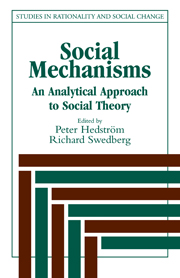Book contents
- Frontmatter
- Contents
- ACKNOWLEDGMENTS
- LIST OF CONTRIBUTORS
- 1 Social mechanisms: An introductory essay
- 2 Social mechanisms and social dynamics
- 3 A plea for mechanisms
- 4 Real virtuality
- 5 Concatenations of mechanisms
- 6 Do economists use social mechanisms to explain?
- 7 Social mechanisms of dissonance reduction
- 8 Social mechanisms without black boxes
- 9 Is sociological theory too grand for social mechanisms?
- 10 Theoretical mechanisms and the empirical study of social processes
- 11 Monopolistic competition as a mechanism: Corporations, universities, and nation-states in competitive fields
- 12 Rational imitation
- AUTHOR INDEX
- SUBJECT INDEX
2 - Social mechanisms and social dynamics
Published online by Cambridge University Press: 24 March 2010
- Frontmatter
- Contents
- ACKNOWLEDGMENTS
- LIST OF CONTRIBUTORS
- 1 Social mechanisms: An introductory essay
- 2 Social mechanisms and social dynamics
- 3 A plea for mechanisms
- 4 Real virtuality
- 5 Concatenations of mechanisms
- 6 Do economists use social mechanisms to explain?
- 7 Social mechanisms of dissonance reduction
- 8 Social mechanisms without black boxes
- 9 Is sociological theory too grand for social mechanisms?
- 10 Theoretical mechanisms and the empirical study of social processes
- 11 Monopolistic competition as a mechanism: Corporations, universities, and nation-states in competitive fields
- 12 Rational imitation
- AUTHOR INDEX
- SUBJECT INDEX
Summary
In the various chapters of this book, social mechanisms are contrasted with theories, laws, correlations, and black boxes. There is near consensus on a hierarchy that has “mere” correlations at the bottom, with laws higher up. Laws that are black boxes (i.e., opaque as to how they work) are, even if fully reliable like the law of gravity, less helpful than laws that work transparently. Theories have less status than laws if the laws are well established and the theories not; theories built on established laws, like the theory of planetary motion, are at the summit.
A pervasive question for social phenomena is the role, or the exclusive role, of “methodological individualism,” the notion that the ultimate unit of analysis is a rational, or at least a purposive, individual. For some of the authors here, any social phenomenon that can not be reduced to the behavior (choices) of individuals is a black box and therefore unsatisfactory. There is some notion that what is inside a black box must be a social mechanism, or several social mechanisms.
What, though, are social mechanisms, and where do they fit? And are social mechanisms little things, big things, or great big things? Did Keynesian theory constitute a social mechanism; is the arms race a social mechanism; is inflation a social mechanism? Or is giggling such a mechanism, or yawning, or the propagation of gossip? On the relation of social mechanisms to theories, I propose that a theory may comprise many social mechanisms, but also a social mechanism may comprise many theories. And a particular issue that arises is whether a social mechanism can be purely mathematical. That may depend on what “purely” means, as I shall propose in a moment.
- Type
- Chapter
- Information
- Social MechanismsAn Analytical Approach to Social Theory, pp. 32 - 44Publisher: Cambridge University PressPrint publication year: 1998
- 61
- Cited by



